
Photo from wikipedia
Atherosclerosis is one of the main underlying causes of cardiovascular diseases (CVD). It is associated with chronic inflammation and intimal thickening as well as the involvement of multiple cell types… Click to show full abstract
Atherosclerosis is one of the main underlying causes of cardiovascular diseases (CVD). It is associated with chronic inflammation and intimal thickening as well as the involvement of multiple cell types including immune cells. The engagement of innate or adaptive immune response has either athero-protective or atherogenic properties in exacerbating or alleviating atherosclerosis. In atherosclerosis, the mechanism of action of immune cells, particularly monocytes, macrophages, dendritic cells, and B- and T-lymphocytes have been discussed. Immuno-senescence is associated with aging, viral infections, genetic predispositions, and hyperlipidemia, which contribute to atherosclerosis. Immune senescent cells secrete SASP that delays or accelerates atherosclerosis plaque growth and associated pathologies such as aneurysms and coronary artery disease. Senescent cells undergo cell cycle arrest, morphological changes, and phenotypic changes in terms of their abundances and secretome profile including cytokines, chemokines, matrix metalloproteases (MMPs) and Toll-like receptors (TLRs) expressions. The senescence markers are used in therapeutics and currently, senolytics represent one of the emerging treatments where specific targets and clearance of senescent cells are being considered as therapy targets for the prevention or treatment of atherosclerosis.
Journal Title: International Journal of Molecular Sciences
Year Published: 2022
Link to full text (if available)
Share on Social Media: Sign Up to like & get
recommendations!